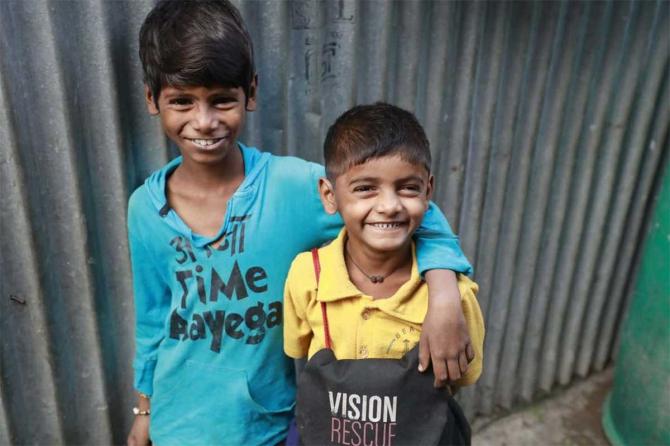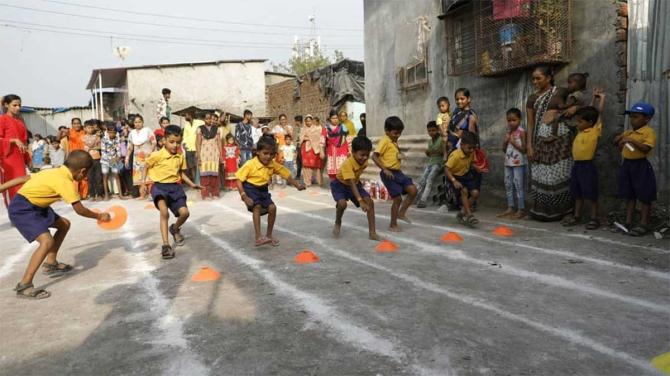kids into classrooms
For imparting education to kids of surrounding areas of Durgapur steel city, Swami Vivekananda Vani Prochar society opened more than 40 schools. About 3000 ( three thousand) kids are being taught there.
Most of the NGOs engage the kids in programmes and later admit them into government schools or small private schools, if their parents can afford the fees. But Swami Vivekananda Vani Prochar Samity of Durgapur Steel City, are always trying to educate the kids through their own schools.

Food and Nutrition for the Kids:
Most of the tribal kids are having lack of nutrients. They are not fed properly. That’s why, society regularly providing them a tiffin which includes a glass of milk, pan cakes, boil eggs.
These kids are from a most vulnerable tribal societies. They are first-generation getting education. Their parents are very poor. Most of them are daily labour. They used to collect shal leaves and supply it to Mahajan. Mahajan gives them very little money to pay for their labour.
Lady volunteers work with these schools and follow up on the kids.
They provide incentivising services to these primary schools like taking over their sports programmes, running their parent-teacher meetings, conducting teacher training programmes, and helping them set up laboratories and libraries.
This provides the children an incentive to become regular.
The other part of sustenance is working with their families, because if the environment in these children’s homes are not healthy, they will drop out.
The kids aren’t motivated to get to school if there is substance abuse, domestic violence or financial problems at home.
The society tries to have a proper understanding of their homes and help create solutions.
Their support programmes include bringing in healthcare, running vaccination camps (for babies and now for COVID), skill training for mothers, de-addiction for father, etc.

Mostly, they are trying to provide shelter, education, sports, and other facilities.
Challenges NGO Face :
The main problem for slum kids is poverty related.
It could be caused due to unemployment and lack of education among their parents, poor sanitation, no running water, substance abuse, lack of proper housing, etc.
For the society, the challenge is limited resources. At times something as simple as finding the right teachers seems like a huge challenge.
Not everyone wants to come and teach in a slum because of the unhealthy conditions there.
To go into that environment and stay there the whole day can be pretty challenging for a qualified person who could get a job elsewhere.
That’s why for the teacher more than employment, it has to be a calling — some kind of passion.
Another challenge is to work with the system.
For example, running water is not available in many slums.
Tankers provide water which is expensive and supplied at specific times.
Several children can’t go to school because they have to get water when the tanker comes.
Then there are times when kids are pulled out of school to look after a younger infant.
These are real-life issues that people face, and to get children to school we need to come up with solutions.
The government’s role in helping educate more children
If the government is system-centric, things won’t work. They have to be people-centric.
When we try to enroll street kids in schools, we are asked about their birth certificates, which these kids don’t have.
It will really help if the government can become more child-centric.
In many places the anganwadi structure is there, but how many of these are functioning?
Also, it is important for the teachers to be passionate. Our society are always beside the teachers. They are given a monthly remuneration. Though it’s very small.
In India, teachers are one of the least paid employees despite teaching being one of the most challenging jobs.
I feel people who are working in challenging environments should be paid more, otherwise there is no motivation for them.
The children attending aganwadis may have problems at home, so there is little motivation for them to attend school.
Their parents would rather have them work and bring home money.
Despite their challenging situations back home, there must be something so attractive for the child to wake up in the morning and say, ‘I can’t wait to go to the anganwadi.’

Read more: Swami Vivekananda’s Mission To West
To sustain children in education, some NGOs also provides them with nutrition, healthcare services and sports education.
Some of the children we have trained are working with us.
It feels so good to see the children, who have come through our educational programme in the early years, finally graduating.
One of my favourite stories is about this child who was with us at a baking centre in a red light area.
When we first got introduced to him, he wanted to become a goonda. Later he wanted to become a policeman.
A few years ago he graduated from high school. At that time when asked what he wanted to do, he said, ‘I want to get educated and work in child protection.’
Stories like that are what make me go back every morning and do it all over again.
A message for people who’d like to help
In school, most of the teachers have said the pledge, ‘All Indians are my brothers and sisters. I love my country…’
If we really mean what we said, that’s enough. One doesn’t need to wait for the government to come forward to help.
If somebody from your family was in need, would you wait for someone to come and help?
Why blame the system when we can start doing things in a small way?
Vivekananda Vani Prochar Society is such a community whose main objective is to do something for the downtrodden society. Sacrifice and service to man is their main motto.
Durgapur, NGOs, Kids, NGOs, Swami Vivekananda Vani Prochar society


Reading your article helped me a lot, but I still had some doubts at the time, could I ask you for advice? Thanks.
Cool. I spent a long time looking for relevant content and found that your article gave me new ideas, which is very helpful for my research. I think my thesis can be completed more smoothly. Thank you.
The point of view of your article has taught me a lot, and I already know how to improve the paper on gate.oi, thank you. https://www.gate.io/tr/signup/XwNAU
Thanks for reading my article.